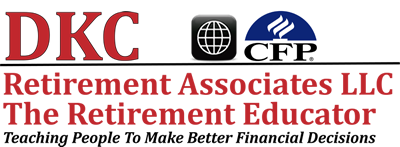The Bucket Approach is a technique used to divide a retiree’s assets into buckets for retirement portfolio management and to provide for retirement income needs. Pioneered by Harold Evensky in the 1980s, Evensky only used only two Buckets, a Cash Bucket (CB) and a diversified total return bucket. The purpose of the CB was to protect a retiree from having to make withdrawals from equity funds in down markets. This would allow equity funds sufficient time to recover from down markets without harming the cash flow needs of a retiree. Evensky’s CB always had two years of income available to withdraw to pay bills. Ideally, this income will supplement Social Security benefits and other guaranteed incomes a retiree may have.
In contrast, the Total Return Bucket (TRB) consisted of a diversified portfolio of Stock funds, bond funds, real estate funds, and perhaps funds of other asset classes. Its purpose was to provide portfolio growth over time. This would allow a retiree to make increasing withdrawals from this account to cover rising expenses. In practice, a retiree would be feeding funds from the TRB to assure that the two-year CB always had two years of inflation increasing expenses covered.
“Feeding” the CB occurred at least quarterly. A retiree had a great deal of discretion in transferring funds from the TRB to CB. Typically, all income (dividends, interest, etc.) were transferred. Furthermore, quarterly rebalancing could provide additional transfers to the CB, especially when growth assets increased significantly beyond its prescribed allocation. Accordingly, the “excess growth” could be added to the CB. For example, if the TRB’s prescribed allocation is 40% fixed and 60% Stock, and a market rise transformed the TRB’s portfolio to 70% Stock and 30% fixed, the 10% “excess” of Stock value might be transferred to the CB. This would provide additional cash to the CB while also serving to return the TRB’s portfolio to its prescribed asset allocation of 40% fixed and 60% Stock.
The Bucket Approach assumes that the retiree has already calculated and assembled the following information:
- the family’s monthly income need,
- the value of the portfolio,
- guaranteed incomes from Social Security, pensions, and other income sources
- the prescribed asset allocation to meet income needs (adjusted for inflation) to last until age 100
These values will help the retire identify:
- the income shortfall needed to fund the CB (two years of needed income)
- the minimum risk profile for the portfolio for the TRB (prescribed asset allocation)
The retiree will need this information to identify the amount necessary to fund the CB, and to identify the least risky asset allocation (in the TRB) to provide inflation adjusted purchasing power to meet the retiree’s income needs until age 100.
Since Evensky’s initial work, others have developed variations of the bucket approach. Most have added buckets and divided them in time segments over an assumed 30-year retirement. The CB still contains guaranteed investments, but generally has enough funds to cover 3 to 5 years of income not met by the retiree’s guaranteed income sources. Since there has never been a bear market in the USA that has exceeded three years since World War II, many suggest 3-5 years is sufficient. More conservative retirees could extend the income shortfall beyond 3-5 years for added income protection.
A Second Bucket (SB) contains investments with modest risk to principal. This will allow the retiree to generate growth greater than offered by short-term investments, while limiting downside risk. Short to intermediate bond funds and conservative real estate funds could populate the second bucket. Over time, the SB will gradually meld with the CB, providing additional guaranteed funds.
The Third Bucket (TB) contains the stock funds that will rise and fall with stock market gyrations. The retiree will need the growth this bucket provides to increase the CB as the retiree’s income needs rise with inflation.
As gains occur in the TB, excess growth not needed to meet expenses, can be transferred to the CB to maintain the retiree’s guaranteed cushion. In down market years, the retiree can “cannibalize” the CB (draw down the principal) to meet current income needs. As noted, the presence of the CB protects the retiree from depleting the TB in episodic stock market swoons. This protects the TB by allowing it enough time to recover from market lows to provide the retiree with long-term inflation protection. As inevitable changes occur (and unforeseen circumstances arise), the retiree can revisit the family’s asset allocation assuring that the portfolio stays current.
Finally, as a retiree reaches his/her mid-80s, he/she will need a late retirement income strategy. Generally, the retiree could reduce the CB to three years of income protection, and then consider annuitizing some or most of the assets remaining in the TB. At this advanced age, annuitization will greatly increase income while protecting the retiree from: outliving his portfolio, market crashes, and cognitive decline. Health considerations, assets remaining, current income needs, and legacy goals will influence how much of the portfolio (if any) to annuitize.
